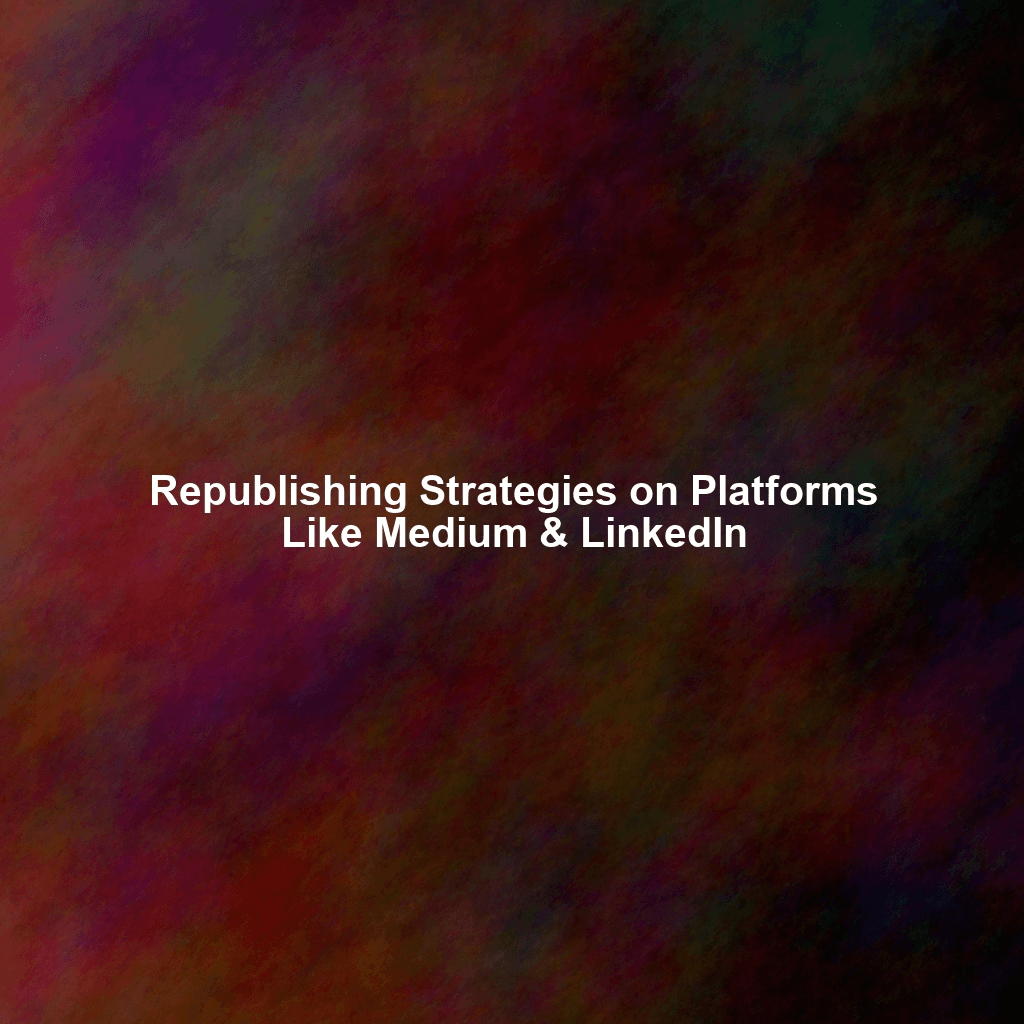Republishing Strategies on Platforms Like Medium & LinkedIn: Extend Your Reach and Amplify Your Message
In the ever-evolving world of content marketing, efficiency is key. Creating high-quality content takes time and effort. What if you could squeeze even more value from each piece you produce? That’s where strategic republishing comes in. Platforms like Medium and LinkedIn offer fantastic opportunities to reach new audiences and reinforce your message by repurposing your existing content. However, it’s not as simple as copy-pasting. A well-planned republishing strategy is crucial to avoid pitfalls and maximize impact.
Why Republish Content? The Benefits of Amplification
Republishing isn’t about being lazy. It’s a smart and legitimate content marketing tactic with several powerful benefits:
- Expanded Reach: Different platforms cater to different audiences. Republishing on Medium or LinkedIn exposes your content to readers who might not frequent your own website or blog.
- Improved SEO: While often debated, strategic republishing, when done correctly, can indirectly boost your overall SEO. More visibility means more opportunities for backlinks and social shares, which contribute to higher rankings.
- Thought Leadership: Regularly sharing insightful content positions you as an expert in your field. Republishing allows you to consistently reinforce your knowledge and build credibility.
- Increased Engagement: Different platforms encourage different types of engagement. You might find that your content sparks conversations on LinkedIn that it didn’t on your blog.
- Content Longevity: Give older, valuable content a new lease on life. Republishing ensures that your evergreen content continues to generate value long after its initial publication.
The Challenges: Avoiding Duplicate Content Penalties
The biggest concern surrounding republishing is the dreaded duplicate content penalty. Google penalizes websites that publish identical content across multiple locations, as it can dilute search results and negatively impact user experience. Therefore, a smart approach is essential. Here’s how to mitigate this risk:
- Canonical Tags: The most important tool in your arsenal. Use canonical tags to tell search engines which version of your content is the original and authoritative source. This prevents them from viewing the republished version as duplicate content. The canonical tag goes in the <head> section of the HTML on the republished page and points back to the original URL on your website.
- Noindex Tag: In some cases, you might choose to use the “noindex” tag instead of a canonical tag. This tells search engines not to index the republished page at all, effectively removing it from search results. This can be a good option if you’re primarily focused on reaching the platform’s audience and not driving SEO traffic directly from the republished content.
- Substantial Modification: While not always necessary, making significant changes to the content can also help avoid duplicate content issues. This could involve rewriting sections, adding new information, updating statistics, or changing the format.
Platform-Specific Strategies: Medium vs. LinkedIn
Medium and LinkedIn are both powerful platforms for republishing, but they have distinct audiences and features, requiring tailored strategies.
Republishing on Medium
Medium is a publishing platform with a large and diverse readership, particularly interested in in-depth articles, personal essays, and thought-provoking content. Here’s how to approach republishing on Medium:
- Importing vs. Copy-Pasting: Medium offers an “Import a Story” feature that automatically adds a canonical link back to your original article. This is the recommended method to ensure proper attribution and avoid duplicate content penalties. Avoid simply copying and pasting the content.
- Tailor for the Medium Audience: While you’re not drastically rewriting the piece, consider making minor edits to align with Medium’s style and audience. Shorten paragraphs, use more visuals (if applicable), and adapt the tone to be more conversational.
- Choose Relevant Publications: Medium allows you to submit your articles to publications with established audiences. Research publications relevant to your niche and follow their submission guidelines. Being accepted into a publication can significantly boost your visibility.
- Engage with the Community: Respond to comments, highlight interesting sections, and participate in discussions. Building relationships with other Medium users can help amplify your content.
- Track Your Results: Monitor your views, reads, and claps on Medium to gauge the effectiveness of your republishing strategy. Use this data to refine your approach.
Republishing on LinkedIn
LinkedIn is a professional networking platform, making it ideal for sharing content related to business, career advice, industry trends, and leadership. Here’s how to approach republishing on LinkedIn:
- LinkedIn Articles vs. Posts: LinkedIn offers both articles (long-form content) and posts (short-form updates). For republishing, you’ll typically want to use the “Article” feature, which is designed for longer pieces of content.
- Focus on Professional Relevance: Ensure that your republished content is relevant to LinkedIn’s professional audience. Frame your content in a way that highlights its value for career development, business growth, or industry insights.
- Write a Compelling Introduction: LinkedIn users are often bombarded with content, so it’s crucial to grab their attention with a strong introduction. Clearly state the value proposition of your article and why it’s relevant to their professional lives.
- Utilize Visuals: LinkedIn is becoming increasingly visual. Adding relevant images, videos, or presentations to your articles can significantly increase engagement.
- Promote and Engage: Share your republished article with your LinkedIn network and encourage your connections to engage with it. Respond to comments and participate in discussions to build relationships and expand your reach. Consider joining relevant LinkedIn groups to share your content and connect with like-minded professionals.
- Monitor Analytics: LinkedIn provides detailed analytics on your articles, including views, likes, comments, and shares. Track these metrics to understand what resonates with your audience and optimize your content strategy.
Republishing Checklist: Key Considerations Before You Hit Publish
Before republishing any piece of content, run through this checklist to ensure you’re maximizing its impact and avoiding potential pitfalls:
- Is the Content Still Relevant? Ensure the information is up-to-date and accurate. Outdated content can damage your credibility.
- Have I Chosen the Right Platform? Consider the target audience and the type of content that performs well on each platform.
- Have I Added a Canonical Tag (or Noindex Tag)? This is crucial for SEO. Ensure the tag is correctly implemented and points to the original source.
- Have I Optimized for the Platform? Adapted the formatting, tone, and length to suit the platform’s audience and style.
- Have I Included a Call to Action? Encourage readers to visit your website, download a resource, or contact you.
- Am I Prepared to Engage? Be ready to respond to comments, answer questions, and participate in discussions.
Beyond Medium and LinkedIn: Exploring Other Republishing Avenues
While Medium and LinkedIn are popular choices, don’t limit yourself. Consider other platforms that align with your target audience and content format. This could include:
- Industry-Specific Websites and Blogs: Many industries have influential websites and blogs that accept guest posts or republish content from other sources.
- Social Media Platforms: While not technically republishing in the traditional sense, you can repurpose key takeaways and snippets from your content to create engaging social media posts.
- Email Newsletters: Curate and share your best content with your email subscribers to drive traffic and engagement.
Conclusion: Repurpose, Repromote, Reignite
Republishing is a powerful and cost-effective content marketing strategy when implemented strategically. By carefully considering your audience, optimizing for each platform, and prioritizing SEO best practices, you can extend the reach of your content, build your brand authority, and drive meaningful results. Embrace the power of repurposing and watch your content marketing efforts flourish. Don’t just create content; create content that works harder for you.
 Skip to content
Skip to content

